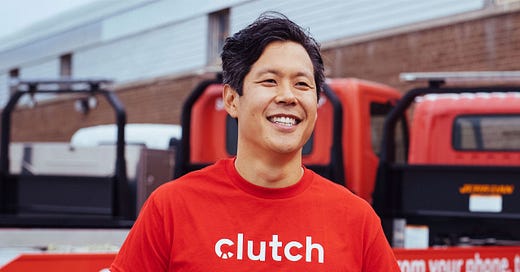Clutch has had an incredible ride. As the “Carvana of Canada” it was a highflier in 2021. It had a brush with death in 2023 and effected an incredible turnaround. They are now once again on a tear. Dan Park, Clutch’s Founder & CEO, joined us to share all the lessons learned along the way.
In addition to the above YouTube video and embedded podcast player, you can also listen to the podcast on iTunes and Spotify.
Transcript
Fabrice Grinda: Hi everyone! I hope you're having a wonderful week. I'm very excited because this week we're going to be talking about like the incredible story of Clutch, kind of like the Carvana of Canada, which I'd like was a super high flying. I had a brush with death and then I had an extraordinary comeback and they're now once again on a tear.
And there are a lot of lessons that learned to learn here for all of us in terms of what to do in different circumstances, and I'm looking forward to doing it. So with that, any further ado, let's get going. Welcome to episode 49. Clutch and the incredible comeback story.
So Dan thank you for joining us.
Dan Park: Thanks for having me. This is great.
Fabrice Grinda: So why don't we start with like a little bit of your background then again, what led to the creation of Clutch?
Dan Park: So I think maybe like most entrepreneurs fell into use car sales as a medium for trying to build something big.
But originally started my career in finance. Actually spent some years on your side of the table doing VC or at stage investing which I loved. But felt like there was this yearning to actually pull some levers myself, I felt like in the different disciplines of finance, VC is probably the closest to pulling some of those levers, but you're not there. Certainly day to day and got an opportunity to join Uber back in 2016. And at the time Uber was toying with some different business ideas outside of cars. They created this group called Uber, everything, which ironically was.
Not everything, it was everything that wasn't ride sharing. So it was probably nothing. But Travis was still there at the time and Travis asked the question, you know, if you can get a car to someone in five minutes, what can you bring to someone in five minutes? And so I. It was a first, first there was an experimentation around food.
Started seeing some signals around demand and people wanting food on demand. And that was kind of like the early days of food delivery. DoorDash was, you know, certainly gaining momentum back then. There were other models around the world just eat takeaway in, in Europe and just Uber Eats was just getting started and actually globally, it started out in Toronto, which is where I'm based.
And so it was fun to watch and, and be a part of that. From super early on, we were, the first iteration was not even a marketplace. It was a bunch of people. Getting into Ubers, or sorry, getting food, meeting in parking lots, stuffing 25 sandwiches into an Uber. And there wasn't a separate app for the Eats product at that point.
It was just the Uber app. And then instead of going UberX, there was Uber Instant and so on a given day, there was, you know, burgers, there was some Pad Thai, there was some me sandwiches and like, you selected what you wanted and it would come to your door. But inventory planning was a disaster because, you know, one driver would run outta their 25 sandwiches within an hour, and then another driver would still be driving around with, you know, 50 Pad Thai four hours later.
But it was, the early signal of food delivery on demand and we started at that point acquiring restaurants. We built, you know, what is now the current version of the Uber Eats app. And that was done in a conference room here locally over three months. Super raw MVP, but we got it out.
Fabrice Grinda: And you were based in Toronto for that period?
Dan Park: Based in Toronto and the business and started globally out of the Uber Eats product started globally outta Toronto. So we were the launch city.
Fabrice Grinda: Oh wow. That's amazing!
Dan Park: I think it's one of those things where, you know, if Uber messed it up, it would be like, oh, it's one of those things that Canadian, Canada did that, you know, sweep that under the rug.
That was a mistake. But it was successful. And, you know, my P&L went from zero to 3 billion within three years. At least in GMV. And you know, we learned a lot about marketplaces. The three-sided marketplaces, super complex with drivers and we call them eaters, drivers, and restaurants.
And It was tough cause it was one of these marketplaces where it's really hard to make anyone happy. Because drivers wanted to get paid more, restaurants wanted to pay less, and, and, and customers really don't want to pay more than five, $6 for delivery. And so that threading of the needle in terms of marketplace balance and for pricing and take rates was challenging.
And at one point I think we were burning something like 400 million a year. And Travis came in and was like, what are you guys? I think we were losing $17 a trip in New York City and you know, basically like who this business is, this business work? And someone had to go prove the unit economics.
And so within a span of eight weeks the Atlanta market and then ourselves. Basically had the Toronto market, cause we were the two earliest markets, had to figure out how to get to unit economics positive in a very short period of time. We did it and then we went back into growth mode.
Fabrice Grinda: Amazing.
Dan Park: Yeah. And then you know, yeah, I, I was there for about, just over three years and a board member at Clutch, who I knew from my VC days approached me and said, Hey, look, there's this like really early stage company pre-seed. They're selling cars online and delivering cars online.
You're delivering food online, you should do this instead. And got really excited about the white space that was used cars in Canada. I think it's the last real e-commerce category that hasn't been fully disrupted by, or sorry, retail category that's been fully disrupted by e-commerce. And in Canada, unlike the US where there are some larger brands like CarMax, for example, in the US there is no real brand for used car retail in Canada.
And it's such a complicated transaction with so much so much opacity and lack of transparency around the, the transaction. And it felt like there was a better way. And so we, we've now built effectively a fully managed marketplace around used cars in Canada.
Fabrice Grinda: And so when did you join Clutch at the pre-seed level?













Share this post